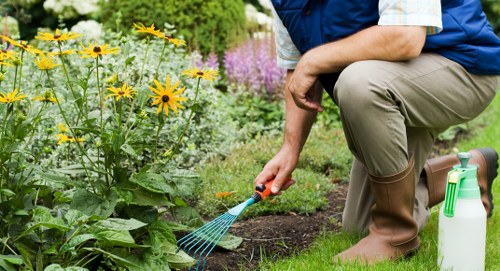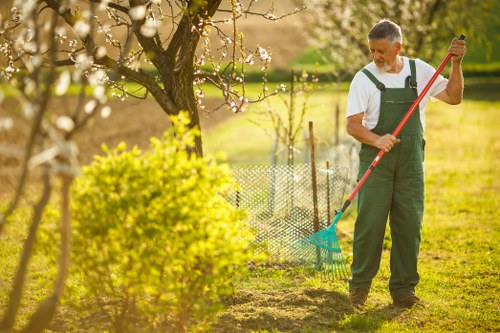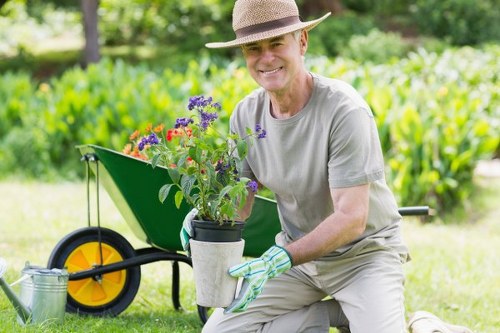Comprehensive Guide to Garden Maintenance in Shortlands

Introduction to Garden Maintenance
Maintaining a beautiful garden in Shortlands requires a combination of knowledge, dedication, and the right resources. Whether you’re a seasoned gardener or a beginner, understanding the fundamentals of garden upkeep is essential for ensuring your outdoor space remains vibrant and healthy throughout the year.
Shortlands' unique climate and soil conditions present both opportunities and challenges for gardeners. By tailoring your maintenance practices to suit these local conditions, you can achieve a lush and thriving garden.
In this guide, we will explore the key aspects of garden maintenance, including seasonal care, plant selection, soil health, and efficient watering techniques, all specifically adapted to the Shortlands area.

Seasonal Garden Care
Spring Maintenance
Spring is a crucial time for garden maintenance in Shortlands. As the weather warms, it’s the perfect opportunity to prepare your garden for the growing season.
Key Tasks:
- Soil Preparation: Enrich the soil with compost or well-rotted manure to provide essential nutrients for new growth.
- Pruning: Trim back any dead or damaged branches from trees and shrubs to encourage healthy development.
- Planting: Sow seeds or transplant young plants once the risk of frost has passed.
Proper spring maintenance sets the foundation for a flourishing garden, ensuring plants have the best start possible.
Summer Maintenance
Summer brings long days and warm temperatures, which demand regular attention to keep your garden in top condition.
Essential Summer Tasks:
- Watering: Ensure plants receive adequate water, especially during dry spells. Early morning or late evening watering reduces evaporation.
- Weeding: Regularly remove weeds to prevent them from competing with your plants for nutrients and water.
- Mulching: Apply mulch to retain soil moisture, regulate temperature, and suppress weed growth.
Consistent summer care helps your garden withstand heat and maintain its beauty even in challenging conditions.

Plant Selection and Care
Choosing the Right Plants
Selecting plants that thrive in Shortlands' climate is vital for a successful garden. Consider factors such as sunlight exposure, soil type, and water requirements when choosing your plants.
- Native Plants: Incorporate native species that are well-adapted to the local environment and require less maintenance.
- Seasonal Bloomers: Plant a variety of flowers that bloom at different times to ensure continuous color and interest throughout the year.
- Drought-Tolerant Varieties: Opt for plants that can withstand periods of low rainfall, reducing the need for frequent watering.
Planting Techniques
Proper planting techniques are essential for the long-term health of your plants. Ensure that you:
- Dig holes twice as wide as the root ball to encourage outward growth.
- Avoid planting too deeply, which can suffocate roots and lead to plant stress.
- Water plants thoroughly after planting to help establish strong root systems.
Regular Plant Care
Maintaining healthy plants involves ongoing care, including:
- Regular watering to keep the soil consistently moist but not waterlogged.
- Fertilizing with appropriate nutrients to support growth and flowering.
- Pruning and deadheading to promote bushier growth and prevent disease.

Soil Health and Fertilization
Healthy soil is the foundation of a thriving garden. In Shortlands, understanding and improving your soil’s composition can lead to better plant growth and resilience.
Soil Testing
Before making any amendments, conduct a soil test to determine its pH level and nutrient content. This information helps you tailor your fertilization and soil improvement strategies effectively.
- pH Levels: Most garden plants prefer a slightly acidic to neutral pH (6.0-7.0). Adjust soil acidity by adding lime to raise pH or sulfur to lower it.
- Nutrient Deficiencies: Based on soil test results, add appropriate fertilizers to address any deficiencies in nitrogen, phosphorus, potassium, or other essential nutrients.
Organic Amendments
Incorporating organic matter into your soil enhances its structure, fertility, and ability to retain moisture. Consider adding:
- Compost: Rich in nutrients, compost improves soil texture and fosters beneficial microbial activity.
- Manure: Well-rotted manure adds organic matter and nutrients, supporting healthy plant growth.
- Peat Moss: Helps retain moisture and improve soil aeration, especially in heavy clay soils.
Fertilization Practices
Implementing a regular fertilization schedule ensures that your plants receive the necessary nutrients throughout the growing season. Follow these guidelines:
- Apply a balanced fertilizer at planting time to support initial growth.
- Supplement with additional feedings during peak growing periods, such as spring and summer.
- Avoid over-fertilizing, which can lead to excessive foliage growth at the expense of flowers and fruit.

Efficient Watering Techniques
Water management is a critical component of garden maintenance, particularly in areas like Shortlands where water conservation may be necessary.
Drip Irrigation Systems
Installing a drip irrigation system delivers water directly to the plant roots, minimizing evaporation and ensuring efficient water use.
- Benefits: Reduces water waste, lowers utility bills, and promotes deeper root growth.
- Installation Tips: Position drip lines close to plant bases and adjust emitters based on individual plant water needs.
Rainwater Harvesting
Collecting and utilizing rainwater for your garden is an eco-friendly way to supplement your watering needs.
- Rain Barrels: Install rain barrels at downspouts to capture runoff from rooftops.
- Storage Capacity: Choose barrels with sufficient capacity to meet your garden’s water requirements during dry periods.
Watering Best Practices
To maximize efficiency and plant health, follow these watering practices:
- Water early in the morning to reduce evaporation and allow plants to absorb moisture before the heat of the day.
- Avoid overhead watering, which can lead to fungal diseases and waste water.
- Use mulch to retain soil moisture and reduce the frequency of watering.
Monitoring Soil Moisture
Regularly check soil moisture levels to ensure plants are receiving adequate water without becoming waterlogged. Techniques include:
- Finger Test: Insert your finger into the soil up to the second knuckle to gauge moisture depth.
- Moisture Meters: Use a soil moisture meter for a more accurate assessment of soil hydration levels.
Dealing with Pests and Diseases
Protecting your garden from pests and diseases is crucial for maintaining plant health and aesthetics. In Shortlands, common pests and issues can be managed through vigilant care and integrated pest management strategies.
Identifying Common Pests
Regularly inspect your plants for signs of pest infestation. Common garden pests in Shortlands include:
- Aphids: These small insects suck sap from plants, causing leaves to curl and stunt growth.
- Slugs and Snails: They feed on plant foliage, leaving behind holes and slime trails.
- Snakes: While not typically harmful to plants, they may cause disturbances in your garden ecosystem.
Natural Pest Control Methods
Implement eco-friendly pest control methods to protect your plants without harming beneficial insects:
- Beneficial Insects: Introduce ladybugs and praying mantises to naturally control pest populations.
- Neem Oil: Use neem oil sprays to deter a wide range of insects without toxic effects.
- Barriers: Apply copper tape or diatomaceous earth around plant bases to prevent slug and snail access.
Disease Prevention
Prevent plant diseases by following good gardening practices:
- Proper Spacing: Ensure plants have adequate spacing to promote air circulation and reduce fungal growth.
- Sanitation: Remove and dispose of diseased plant material promptly to prevent spread.
- Resistant Varieties: Choose plant varieties that are resistant to common diseases in the Shortlands area.
Treatment Options
If your plants do become infected, take immediate action to treat the issue:
- Fungicides: Apply appropriate fungicides to control fungal infections.
- Organic Remedies: Use solutions like baking soda sprays to manage mild disease outbreaks.
- Consistent Monitoring: Regularly check plants for new signs of disease to catch problems early.
Tools and Equipment for Efficient Garden Maintenance
Having the right tools and equipment is essential for effective garden maintenance in Shortlands. Investing in quality tools can make tasks easier and improve the overall health of your garden.
Essential Gardening Tools
- Pruners: For trimming and shaping plants, ensuring healthy growth.
- Garden Fork: Useful for turning and aerating soil, especially in compacted areas.
- Watering Can or Hose: Ensure you can water your plants efficiently and effectively.
Specialized Equipment
Consider adding specialized equipment to enhance your garden maintenance:
- Lawn Mower: Keep your lawn neat and encourage healthy grass growth.
- Leaf Blower: Quickly clear leaves and debris from garden paths and beds.
- Compost Bin: Create your own compost to recycle organic waste and enrich your soil.
Maintenance of Tools
Properly maintaining your gardening tools extends their lifespan and ensures they function effectively:
- Clean tools after each use to prevent rust and corrosion.
- Regularly oil metal parts to keep them in good condition.
- Sharpen blades and replace worn parts as needed to maintain efficiency.
Storage Solutions
Store your gardening tools in a dry, organized space to protect them from damage and make them easily accessible:
- Tool Shed: Invest in a sturdy shed to keep tools safe from the elements.
- Wall Hooks: Use wall-mounted hooks in your shed or garage to keep tools off the ground and organized.
- Tool Organizers: Utilize racks or bins to categorize and store smaller tools and accessories.
Conclusion
Effective garden maintenance in Shortlands involves a combination of regular care, proper plant selection, soil management, and efficient watering practices. By following the strategies outlined in this guide, you can create and maintain a beautiful, healthy garden that thrives in the local climate.
Remember, a well-maintained garden not only enhances the aesthetic appeal of your home but also provides a peaceful sanctuary where you can relax and connect with nature.
Ready to transform your garden? Contact us today to book your garden maintenance service and take the first step towards a stunning outdoor space.